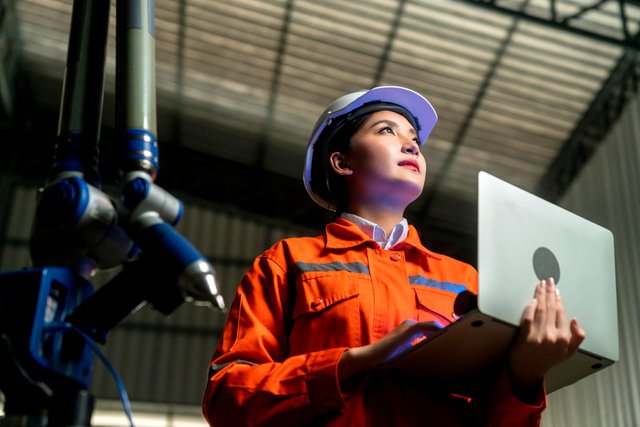The Human Element in Vision AI: Empowering Workers for Better Safety Outcomes

Workplace safety is paramount for organizations spanning diverse industries. Creating a secure work environment not only protects employees but also contributes to operational efficiency. In recent years, the integration of Vision AI or Computer Vision solutions has revolutionized the landscape of workplace safety.
However, the true power of Vision AI lies in its ability to complement and empower human workers, not replace them. In this blog, we will explore the crucial role of the human element in Vision AI applications for workplace safety and how it can lead to better safety outcomes.
Understanding Vision AI in Workplace Safety
Before delving into the human element, let's briefly understand what Vision AI is and how it's utilized in the context of workplace safety. Vision AI, also known as Computer Vision, refers to the use of AI algorithms to process and interpret visual data from cameras and sensors. It can identify objects, patterns, and anomalies in real time, making it a valuable tool for monitoring and ensuring safety in the workplace.
Vision AI systems are employed for a wide range of safety applications, including:
Hazard Warning Applications (https://visionify.ai/hazard-warnings/)
Early Fire Signs Detection
Missing Fire Extinguishers
Equipment Temperatures
Gas Leaks
Spills and Leaks
Blocked Exits Monitoring
Worker Health and Safety Applications
PPE Detection
Slip and Fall Detection
Posture and Ergonomics
Confined Spaces Monitoring
Environment Monitoring
Applications for Compliance
Dwell Time
Max Occupancy
Social Distancing
Occupancy Metrics
Applications for Suspicious Activity Detection
Loitering
Aggressive Behavior
Vandalism
Firearms and Knives
Theft
Unauthorized Shipping Activity
These applications represent just a subset of the many ways Vision AI can enhance workplace safety. Vision AI's ability to monitor, identify, and alert workers to potential hazards in real time is a game-changer for safety protocols and practices in various industries. However, it's essential to remember that the true power of Vision AI is unlocked when it collaborates with human workers to create safer and more productive work environments.
The Complementary Relationship Between Humans and Vision AI

One of the key principles of integrating these high-tech solutions into the workplace is to recognize that it should augment, not replace, human workers. Vision AI systems are not meant to replace the critical thinking, decision-making, and adaptability of human workers but rather to work alongside them.
Human workers bring an invaluable element of contextual understanding, problem-solving ability, and ethical judgment. Vision AI, on the other hand, excels at continuous, unbiased monitoring and processing of visual data, enabling the rapid identification of anomalies.
Worker Empowerment Through Vision AI
The true potential of Vision AI is realized when it empowers workers to make safer decisions.
Here's how this empowerment works:
Increased Situational Awareness: Vision AI provides real-time visual feedback to workers about their environment. This enhanced awareness allows them to take immediate corrective actions when safety risks are detected.
Safety Protocol Compliance: By utilizing Vision AI to monitor compliance with safety protocols, workers are reminded of best practices, leading to safer work habits.
Enhanced Training: Vision AI can be used for immersive safety training. It simulates various hazardous scenarios, helping workers understand and internalize safety practices.
Training and Education
To fully harness the potential of Vision AI, it is crucial to educate and train employees about the technology and its role in safety. Proper training not only ensures that workers understand how to use Vision AI tools effectively but also encourages their acceptance of these systems as safety enablers.
User-friendly interfaces and feedback mechanisms play a vital role in this aspect. A well-designed interface makes it easier for workers to interact with Vision AI tools, while real-time feedback keeps them informed about potential safety issues. When workers feel comfortable using these systems, they are more likely to embrace them as valuable safety tools.
Collaborative Work Environments
Empowering workers through Vision AI goes hand in hand with fostering a culture of collaboration. Workers should view Vision AI as a safety partner, not a surveillance tool. Encourage open communication between human workers and AI systems, allowing them to share observations, suggestions, and concerns.
In organizations where this collaborative approach is embraced, workers are more likely to actively engage with Vision AI systems, leading to improved safety outcomes. Such collaboration can also result in the continuous improvement of safety protocols and procedures.
Positive ROI of Vision AI Technology
Implementing Vision AI technology not only enhances workplace safety but also offers a positive return on investment (ROI) for organizations. Here are a few ways in which Vision AI contributes to a positive ROI;
Reduced Accidents and Incidents: By quickly identifying and addressing safety hazards, Vision AI helps reduce workplace accidents and incidents. This results in lower insurance claims, medical costs, and potential legal expenses, contributing to significant cost savings.
Enhanced Productivity: Safer workplaces lead to increased productivity. When workers feel secure and confident in their environment, they are more focused and efficient in their tasks, ultimately boosting overall productivity.
Cost-Efficient Compliance: Vision AI technology ensures that organizations adhere to safety compliance policies effectively. Avoiding non-compliance fines and penalties leads to substantial cost savings in the long run.
Improved Equipment Lifespan: Regular monitoring and preventive maintenance, facilitated by Vision AI, can extend the lifespan of expensive equipment. This reduces the need for frequent replacements, resulting in substantial cost savings for organizations.
As per OSHA (Occupational Safety and Health Administration), for every dollar invested in workplace safety, companies can realize up to a six-dollar return on investment. An investment made in an effective safety and health program pays off in lower costs, increased productivity, and high employee morale.
Ethical and Privacy Considerations
Last but not least, addressing ethical concerns and privacy considerations is crucial when implementing Vision AI in the workplace. Companies can handle these concerns effectively by opting for on-premise deployment options. With on-premise deployment, organizations fully control their data, ensuring that sensitive information remains within their secure infrastructure. By maintaining data privacy and security, companies can build trust among employees, mitigating privacy concerns and fostering a positive atmosphere in the workplace.
Lastly, Vision AI has the potential to revolutionize workplace safety, but its success depends on empowering workers rather than replacing them. By fostering a collaborative, educative, and respectful environment, organizations can achieve better safety outcomes while reaping the benefits of Vision AI technology.
As the adoption of Vision AI(https://visionify.ai/) continues to grow, organizations need to remember that the human element is irreplaceable. Workers bring a unique set of skills, experiences, and adaptability that complement the capabilities of Vision AI. When these two elements work together, the result is not only safer workplaces but also more productive and efficient operations.